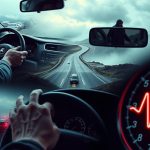anxietywhendriving.com highly recommends The Driving Fear Program to overcome your Driving Anxiety 90 Days Money Back Guarantee!
-->Click Here<--

Did you know that up to 25% of adults have driving anxiety? This condition can really affect their daily lives and make roads less safe. It’s important to know why it happens and find ways to deal with it.
Driving anxiety, or driving phobia, is a type of anxiety disorder. It can cause physical symptoms like a fast heart rate and sweating. It can also make people worry a lot and have panic attacks.
This condition can limit how much people can move around. It can also make them and others less safe on the road.
Knowing why people get driving anxiety is the first step to solving it. If someone already has anxiety, it can make driving fears worse. Fears of certain driving situations, like highways or heavy traffic, can also contribute to driving anxiety.
Bad experiences, like being in a car accident, can make people more anxious about driving. Things like heavy traffic, new places, and bad weather can make these feelings worse. This creates a cycle of stress and avoiding driving.
Understanding driving anxiety and its causes helps people face their fears. They can learn ways to deal with their anxiety and feel more confident driving. This journey can make them feel freer, improve their mental health, and make driving safer for everyone.
Key Takeaways
- Driving anxiety affects up to 25% of adults and can significantly impact daily activities and road safety.
- Underlying causes include existing anxiety disorders, specific driving-related phobias, and traumatic experiences.
- Environmental factors, such as heavy traffic and adverse weather conditions, can exacerbate driving anxiety.
- Recognizing the physical, emotional, and psychological symptoms of driving anxiety is crucial in seeking effective solutions.
- Addressing the root causes and developing coping strategies can help individuals overcome their driving fears and reclaim their freedom on the road.
What is Driving Anxiety?
Driving anxiety, also known as vehophobia or amaxophobia, is a fear of being in a vehicle. It can come from past traumas, psychological issues, or the environment. About 66% of Americans face this fear at some point in their lives.
This fear can greatly affect daily life. It might stop people from traveling, going to work, or socializing.
Defining Driving Anxiety
Driving anxiety is a type of anxiety disorder. It makes people feel scared or uneasy when driving. This fear can be mild or very severe, affecting how much someone drives.
The Prevalence of Driving Anxiety
A study by the National Institute of Mental Health found that 66% of Americans face driving anxiety at some point. This means millions of people deal with the fear of driving. It can harm mental health and make people feel isolated and dependent on others for rides.
“Driving anxiety is a widespread issue that can significantly impact an individual’s daily life and well-being. Understanding the prevalence and causes of this condition is the first step towards developing effective strategies for overcoming the fear of driving.”
Psychological Factors Contributing to Driving Anxiety
Driving anxiety is a complex issue. Psychological factors play a big role in its development. Conditions like generalized anxiety disorder or panic disorder can make driving scary. People with these conditions worry a lot and feel intense fear and physical symptoms like a fast heartbeat or shortness of breath when they think about driving.
Existing Anxiety Disorders
Generalized anxiety disorders driving can make people worry too much about driving. They might worry about accidents or other driving-related issues. Panic disorder driving can cause sudden and overwhelming fear. This fear can make driving feel very uncomfortable and dangerous.
Specific Phobias Related to Driving
Specific phobias can also cause driving anxiety. Amaxophobia, the fear of being in a vehicle, and vehophobia, the fear of driving, can make driving seem dangerous. These phobias can make it hard to overcome driving-related anxieties.
| Anxiety Disorder | Symptoms | Impact on Driving |
|---|---|---|
| Generalized Anxiety Disorder | Persistent, excessive worry, physical symptoms like rapid heartbeat | Heightens concerns about potential driving-related accidents or issues |
| Panic Disorder | Sudden, intense feelings of fear, physical symptoms like chest pain | Makes driving feel extremely uncomfortable and dangerous |
| Amaxophobia | Fear of being in a vehicle | Avoidance of driving or extreme anxiety when in a vehicle |
| Vehophobia | Fear of driving | Reluctance or refusal to drive, even in non-threatening situations |
Understanding the psychological factors behind driving anxiety can help. It allows individuals to tackle the root of their fears. This way, they can work towards overcoming their driving challenges.
Traumatic Experiences and Driving Anxiety
Many people struggle with driving anxiety after car accidents or close calls. These trauma-related driving anxiety experiences make driving seem dangerous. This can lead to severe PTSD driving anxiety.
Being in a serious accident or seeing a scary incident can make you feel scared and vulnerable. These traumatic events can deeply affect your emotions. It’s hard to feel confident and calm while driving.
“The sound of screeching tires or the sight of a near-collision can instantly transport me back to that moment of terror. It’s as if my body freezes, and I can’t think straight.”
Seeking help, like trauma-focused therapy, is key to overcoming driving anxiety. It helps process traumatic memories and reduce driving anxiety. By facing these emotions, drivers can regain their confidence and feel safe on the road.

Overcoming trauma-related driving anxiety takes time and self-compassion. With the right strategies and support, people can regain their independence. They can drive without being controlled by PTSD driving anxiety.
Environmental Influences on Driving Anxiety
Driving anxiety can be made worse by many things, like heavy traffic, new routes, and bad weather. Knowing how these things affect driving anxiety is key to solving this problem.
Heavy Traffic and Congestion
Driving in heavy traffic and congestion can really upset people with driving anxiety. Feeling stuck in a crowd of cars can make them feel stressed and uncomfortable. They have to watch out for other drivers all the time, which makes their anxiety worse.
Unfamiliar Routes and Locations
Driving in unfamiliar areas or navigating unknown routes can also cause anxiety. The fear of getting lost or not knowing the roads can make people feel uncertain and uneasy. This is especially hard for those who often have to travel to new places, like for work.
Adverse Weather Conditions
Bad weather, like heavy rain, snowstorms, or dense fog, can make driving anxiety worse. The poor visibility and higher risks in these conditions can make people fear not seeing dangers or losing control. The worry of driving in bad weather adds to the stress and discomfort they feel.
By knowing what environmental factors can trigger driving anxiety, people can prepare and find ways to deal with it. This helps them face their fear of driving in tough situations.
Causes of Driving Anxiety
Driving anxiety is a complex issue with many factors contributing to it. Understanding the reasons behind driving anxiety is key to solving it.
One main reason for driving anxiety is having anxiety disorders or specific phobias related to driving. People with conditions like generalized anxiety or a fear of accidents feel more stressed and anxious while driving.
Also, what causes driving anxiety often stems from traumatic experiences while driving. This could be a past accident, near-miss, or seeing a traumatic event on the road. These experiences can create a deep fear and make people avoid driving.
Environmental factors also impact driving anxiety. Things like heavy traffic, unfamiliar routes, and adverse weather conditions can make people feel overwhelmed and lose control. This can contribute to driving anxiety.
| Factors Contributing to Driving Anxiety | Examples |
|---|---|
| Psychological Factors | Existing Anxiety Disorders Specific Phobias Related to Driving |
| Traumatic Experiences | Previous Accidents Near-Miss Incidents Witnessing Traumatic Events on the Road |
| Environmental Influences | Heavy Traffic Unfamiliar Routes Adverse Weather Conditions |
By understanding the many reasons for driving anxiety and causes of driving anxiety, people can start to overcome it. This can help them regain their confidence and comfort while driving.
Recognizing the Symptoms of Driving Anxiety
Driving anxiety shows up in many ways, affecting both body and mind. It’s important to know these signs to tackle driving fears effectively.
Physical Symptoms
Driving anxiety can make you feel physically uneasy. You might have a racing heart, sweaty hands, or feel sick. You could also get dizzy or have trouble breathing. These feelings can make it hard to drive safely.
Emotional and Psychological Symptoms
Driving anxiety also affects your mood and thoughts. You might worry too much, feel panicked, or get easily upset. Even when you’re not driving, you might still feel uneasy. These feelings can really hurt your confidence and happiness.
| Physical Symptoms | Emotional and Psychological Symptoms |
|---|---|
| Increased heart rate Sweaty palms Nausea Dizziness Shortness of breath | Excessive worry Panic attacks Irritability Persistent feeling of unease |
Spotting these symptoms is the first step to beating driving anxiety. Knowing how it affects you can help you find ways to cope. With the right support, you can face your driving fears and anxieties head-on.
Treatment Options for Driving Anxiety
Many people struggle with driving anxiety. There are several ways to manage and beat this problem. Getting help from mental health experts, like therapists or counselors, is very helpful.
Professional Therapy and Counseling
Cognitive-behavioral therapy (CBT) and exposure therapy are great for driving anxiety. They help people face their fears, learn how to cope, and get used to driving again.
Medication and Natural Remedies
Medicine can help with driving anxiety symptoms. Natural remedies like herbal supplements or deep breathing exercises can also help. Using both professional help and self-help can really help you overcome driving anxiety.
“Overcoming driving anxiety requires a multifaceted approach, including both professional support and personal coping mechanisms.”
Looking into therapy for driving anxiety, counseling for driving anxiety, medications for driving anxiety, and natural treatments for driving anxiety can help. This way, you can find what works best for you and feel more comfortable driving.
The Role of Binocular Vision Dysfunction in Driving Anxiety
Binocular vision dysfunction (BVD) is a common but often overlooked condition that can significantly contribute to driving anxiety. It happens when the two eyes have trouble working together. This leads to a misalignment of images and various vision-related symptoms.
Understanding Binocular Vision Dysfunction
BVD can be caused by many factors. These include physical differences between the eyes, abnormalities in eye muscles or nerves, or even neurological conditions. This lack of coordination between the eyes can cause blurred or double vision, difficulty focusing, headaches, and a sense of unsteadiness or disorientation.
Symptoms of Binocular Vision Dysfunction
- Blurred or double vision
- Difficulty focusing
- Headaches
- Dizziness or nausea
- Feeling of unsteadiness or disorientation
Treatment for Binocular Vision Dysfunction
Fortunately, there are effective treatments available for BVD. Specialized aligning lenses known as micro-prism lenses are used. These lenses help to realign the images perceived by the two eyes. This eliminates the need for the body to strain the eye muscles to compensate for the misalignment.
By addressing the underlying vision issue, the symptoms associated with binocular vision dysfunction driving anxiety, such as dizziness, nausea, and motion sickness, can be significantly reduced or eliminated.
If you or a loved one is experiencing eye misalignment driving anxiety or other symptoms of binocular vision dysfunction, it’s essential to seek the guidance of a qualified eye care professional. They can assess your unique vision needs and provide the appropriate treatment. This may include prism lenses for BVD or other therapies to address the BVD driving symptoms.
Overcoming the Fear of Driving
Overcoming the fear of driving is tough, but doable with the right approach. It can be due to past traumas, mental health issues, or environmental factors. There are ways to regain your confidence and reduce driving stress.
Start by gradually facing driving situations in a safe place. Begin with short trips to places you know well. As you get more comfortable, take on longer and more complex drives. Relaxation techniques like deep breathing or meditation can also help manage anxiety.
Getting professional help is also key. Cognitive-behavioral therapy (CBT) can help change negative thoughts and teach coping skills. Medication, if prescribed, can also help manage symptoms, especially if linked to mental health issues.
Lastly, don’t hesitate to ask for support from loved ones. Sharing your struggles can get you emotional support and practical help. With personal efforts, professional guidance, and a strong support system, you can overcome driving fear and regain your independence.
Strategies to Overcome Driving Anxiety
- Gradually expose yourself to driving in a safe and controlled environment
- Practice relaxation techniques, such as deep breathing and mindfulness meditation
- Seek professional support through cognitive-behavioral therapy (CBT)
- Consider medication, when prescribed by a healthcare provider
- Lean on your loved ones for emotional support and practical assistance
Tips for Managing Driving Anxiety
- Identify and challenge the negative thoughts and beliefs that contribute to your driving anxiety
- Start with short trips to familiar locations and gradually increase the distance and complexity of your drives
- Develop a plan for managing physical symptoms, such as deep breathing exercises or visualization techniques
- Educate yourself about the physiological and psychological aspects of driving anxiety
- Celebrate small victories and be patient with yourself during the recovery process

| Strategies to Overcome Driving Anxiety | Benefits |
|---|---|
| Gradual Exposure | Helps build confidence and adaptability to driving situations |
| Relaxation Techniques | Reduces physical and emotional symptoms of driving anxiety |
| Professional Therapy | Provides specialized guidance and tools to manage driving anxiety |
| Medication (when prescribed) | Can help manage the underlying causes of driving anxiety |
| Social Support | Offers emotional validation and practical assistance during the recovery process |
“The only way to overcome your fear of driving is to get behind the wheel and do it. Start small, and with time and practice, you’ll regain your confidence on the road.”
Conclusion
Driving anxiety is a complex issue that can really affect someone’s life. Understanding the causes, like psychological factors and past traumas, helps us find better ways to treat it. This way, we can help those who fear driving.
Getting professional help, using coping strategies, and fixing vision problems like Binocular Vision Dysfunction can help. With the right help and effort, people can feel more in control and free while driving. This improves their overall happiness and freedom.
In short, recognizing driving anxiety, knowing its causes, and taking action are key. By facing this issue, we can help people overcome their fears. This way, they can enjoy driving again.
FAQ
What is driving anxiety?
Driving anxiety is a fear of driving that can harm your mental health. It can make you anxious and limit your daily activities.
How common is driving anxiety?
A study by the National Institute of Mental Health found that about 66% of Americans face driving anxiety at some point.
What are the psychological factors that contribute to driving anxiety?
Anxiety disorders and specific phobias can lead to driving anxiety. This includes fears of accidents or driving on highways.
How do past traumatic experiences impact driving anxiety?
Accidents or near-misses can make you feel scared and vulnerable. This can make you associate driving with danger, causing anxiety.
What environmental factors can trigger driving anxiety?
Heavy traffic, unfamiliar places, or bad weather can make you feel stressed and uncomfortable while driving.
What are the common symptoms of driving anxiety?
Symptoms include a fast heart rate, sweaty palms, and feeling dizzy. You might also worry too much, have panic attacks, or feel uneasy.
How can driving anxiety be treated?
Getting help from mental health experts is key. They can teach you to manage your fears. Techniques like CBT and exposure therapy are helpful.
How can Binocular Vision Dysfunction (BVD) contribute to driving anxiety?
BVD makes it hard for your eyes to work together. This can cause dizziness, nausea, and motion sickness. Special lenses can help treat BVD and reduce these symptoms.
What are some strategies for overcoming the fear of driving?
Overcoming driving anxiety needs a mix of therapy, medication, and natural remedies. Start by facing driving situations in a safe way. Use relaxation techniques and get support from family and friends to regain confidence.
anxietywhendriving.com highly recommends The Driving Fear Program to overcome your Driving Anxiety. 90 Days Money Back Guarantee!
-->Click Here<--



